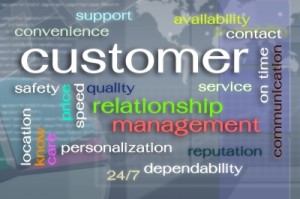 Your company’s brand values, marketing strategy and communication techniques all play a part in determining the kinds of customers you’re likely to attract, right? Well, this process is a two-way street.
Your company’s brand values, marketing strategy and communication techniques all play a part in determining the kinds of customers you’re likely to attract, right? Well, this process is a two-way street.
To attract a specific target audience, it is important that you establish the right brand values, using the right communication channels, in order to get that audience on your side. Get it wrong and your company can easily end up attracting the ‘wrong’ types of customers — those that cost you a lot of time and money, while doing little to help your business progress and grow.
The effects of attracting these ‘wrong’ types can be:
- Customers make one-off purchases and never return, or purchase very infrequently
- You have few conversions (proportion of actual sales to something like your website traffic, for instance, is very small)
- Customers are reluctant to respond to communication such as emails, phone calls, polls or surveys
- Customers frequently want discounts or lower prices.
If you spot any of these signs occurring over a period of time, then you’re probably not attracting the right audience.
So what can companies do to change this?
Write a Positioning Statement
For companies seeking a rebrand, this is especially important. Not only will it form the very foundation of your brand (thus influencing design, copy and marketing); it will also determine the angle from which everything else will follow (your rules, policies, practices and culture). It should be addressed as step one, before anything else happens, and will make it much easier to deal with bumps and hiccups that may occur further down the line.
When writing your positioning statement, you should be striving to answer the following questions:
- Who is likely to get the most benefit from this product or service?
- What are their needs/wants/desires? (Can be both relevant to the product and non-relevant)
- How can this product help with this need or desire?
- How can we bring this product to our audience in a way that is fast, easy and accessible?
- How does this product help us stand out from our competition; what do we do differently?
- How else can we as a company demonstrate commitment to solving other issues that are important to our target audience?
According to branding consultant Craig McBreen, your positioning statement should be no longer than four to five sentences, and this exercise will clarify your purpose and drive focus.
Remember That You Can’t Cater To Everyone
In an ideal world, your business would cater to a multitude of audiences, all who would get maximum benefit from your services, leading to maxed out profits for you. But this is an impossibility and trying to entertain it will only waste time and money, no matter how good your customer service might be.
Avoid choosing a market that is too varied, or aiming to appeal to lots of different audiences. There is nothing wrong with identifying your ‘perfect’ customer and aggressively going after that. When you have reached the point where you are successfully meeting the needs of one target audience repeatedly, you can then think about moving on to other types of audience in order to grow and expand.
Refine Your Content
Susan Oakes of M4B Marketing urges that companies should create a profile of their ‘ideal’ customer so that they are able to target them more accurately. As well as the basics such as their age, gender, location, income, and profession, you should also outline the finer details such as their likes and dislikes, their desires and their interests and hobbies. If you already have a strong relationship with some of your customers, feel free to use their profile as a guide. Once you have this profile, you can then begin to refine or refresh your content in order to appeal to your target’s mindset.
What kinds of questions will your target audience be asking? Your content must answer everything they would wish to know, plus any other information that would benefit them. Think about what kinds of offers would be likely to entice them — what would help them the most? Hook your audience with a lucrative offer they can’t refuse, and you’ll have the chance to turn them into repeat customers later.
It is also important to assume the right voice and manner for your content that will resonate with your target customers. How do they talk and express themselves? What language do they use; what’s their tone of voice? Integrate the right register into all of your communications, including emails and social media, and your audience will be more likely to respond.
Have an Accessible Marketing Plan
Besides having the appropriate tone of voice, your marketing should stretch to every corner where your target audience may be. Where do they like to hang out? What sites and blogs do they visit? What magazines do they read? Wherever they like to go and whatever they like to do, you should be in the same places and doing the same things as your customers to get a better understanding of their lives. When it comes to reaching out, you should meet your customers halfway … but it’s much more preferable to have them not need to lift a finger.
This knowledge, along with your company’s positioning statement, should help determine almost every aspect of your marketing plan. This includes your website’s design, usability and accessibility, the placement of your advertisements and the way in which you talk and build relationships over social media and mailings.
It takes time no doubt to build up this knowledge, and really define what your company is fundamentally all about. But spend time getting these strong foundations in place, and you’re sure to have no problems attracting the customers you’ll love … and who’ll love you back.
What other effects are there to attracting the ‘wrong’ type of customer? What steps has your business taken to ensure you are attracting the ‘right’ ones? We’d love to hear your insight — Leave a comment below, or connect with us on Facebook, Twitter or Google+.
Author Bio: Adele Halsall writes for Customer Service Guru. She is an expert in customer service trends and practices. She regularly contributes to debates and industry blogs. Have a question? Tweet her @gurucustomers.

No Comments